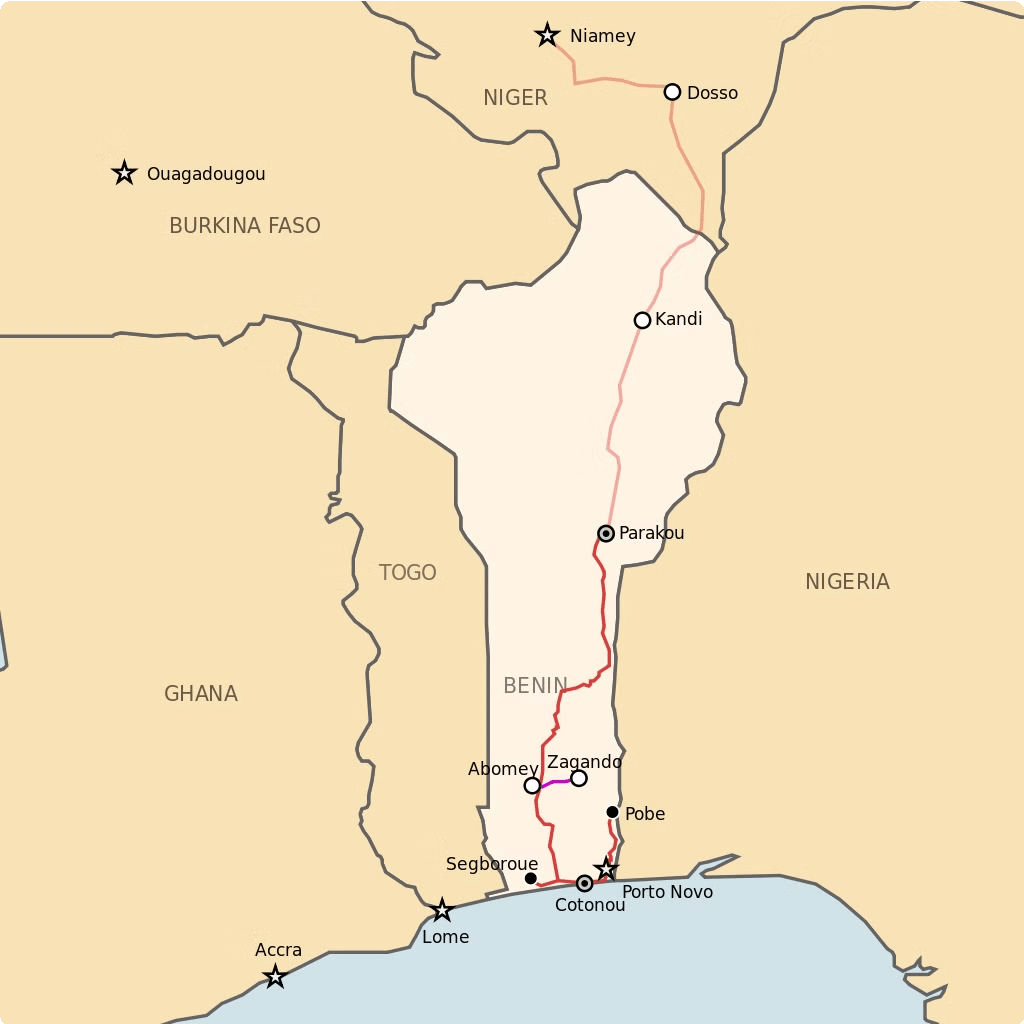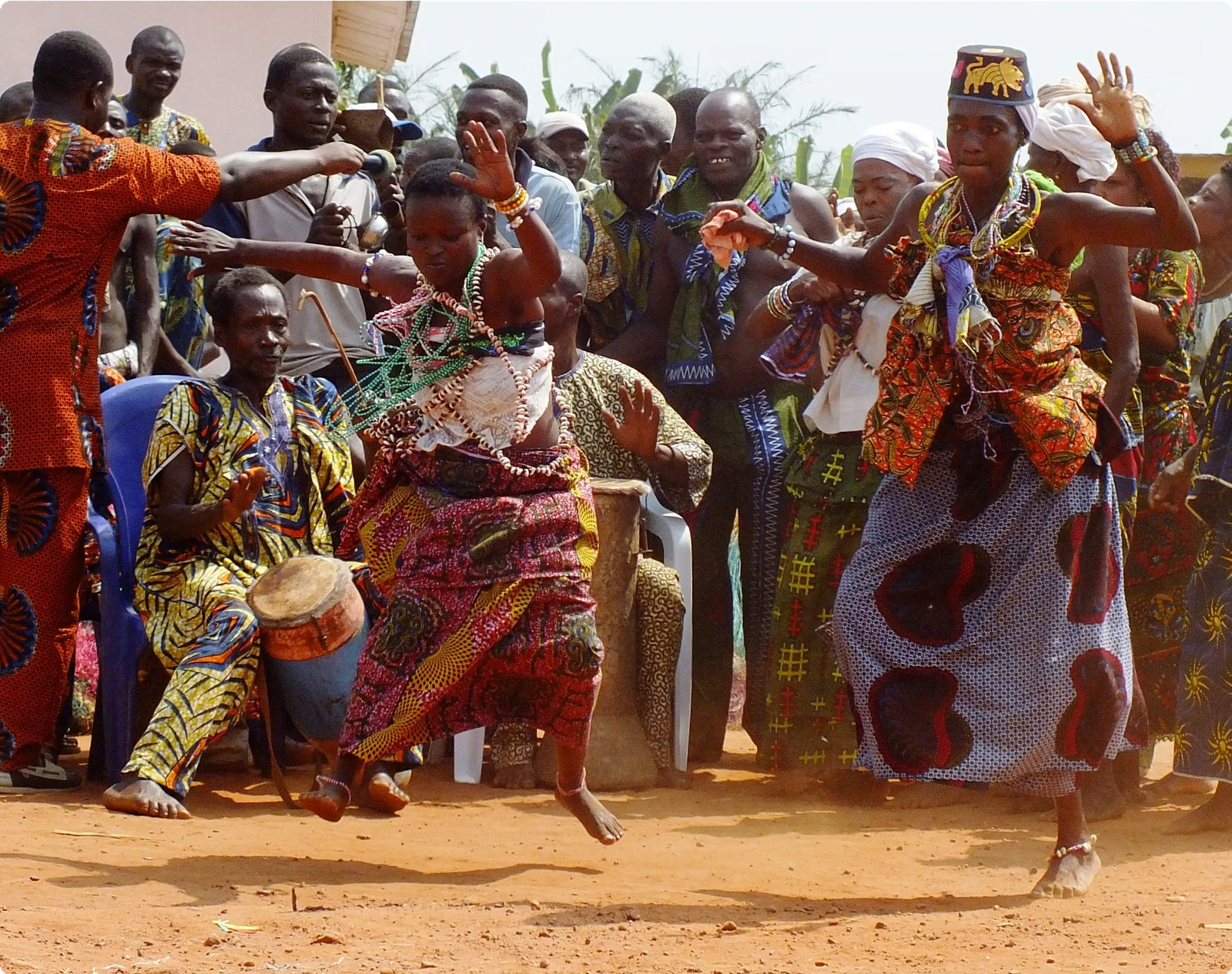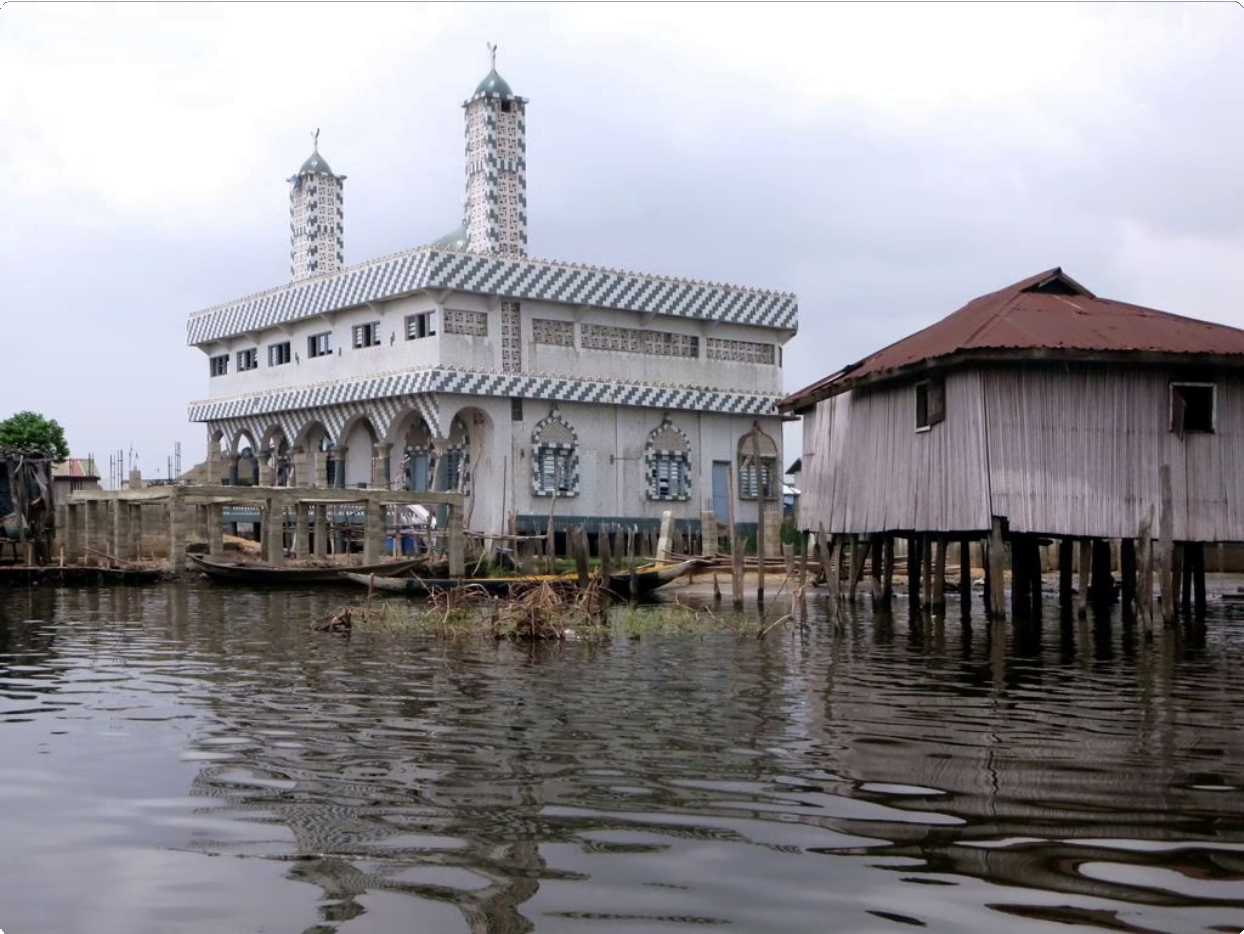Benin
Discover Benin
Benin, a culturally rich country located in West Africa, boasts a fascinating blend of history, tradition, and modernity. With its diverse landscapes, vibrant cities, and welcoming locals, Benin offers a unique travel experience for visitors. From the bustling markets of Cotonou to the tranquil beauty of the Pendjari National Park, there is something for every type of traveler. Whether you’re an avid adventurer, a history enthusiast, or a foodie looking to sample traditional West African cuisine, Benin has much to offer. This section will provide a comprehensive overview of the country’s currency, economy, culture, food, and much more.
Location and Geography
Benin, located in West Africa, is bordered by Togo to the west, Nigeria to the east, and Burkina Faso and Niger to the north. It has a diverse geography that includes coastal plains, savannas, and plateaus. The Oueme River, the longest river in the country, flows through the south, while the Pendjari River crosses the north. The landscape is dotted with lush forests and wildlife reserves, making it a haven for nature enthusiasts.

The southern coastline of Benin offers beautiful sandy beaches and lagoons, while the north boasts the stunning Atakora mountain range. The country experiences a tropical climate with a dry season from November to April and a rainy season from May to October, providing a rich and varied landscape throughout the year.
Flag and National Symbols
National Flag
The flag of Benin consists of two horizontal bands of yellow and red with a vertical green band on the hoist side. The colors hold significant symbolism – the yellow represents the wealth of the country, the green symbolizes hope, and the red represents the sacrifices made for the nation’s independence.

National Emblem
The national emblem of Benin features a crown with five points, symbolizing the relationship between the government and the people. It is surrounded by two leopards, which represent courage and a shield adorned with the national flag. The motto “Fraternité, Justice, Travail” (Brotherhood, Justice, Work) is inscribed at the bottom, reflecting the country’s core values.
National Anthem
“L’Aube Nouvelle” (The Dawn of a New Day) is the national anthem of Benin. It speaks of the country’s freedom, unity, and aspirations for a prosperous future. The anthem is a source of pride, evoking a sense of patriotism and national identity among the people of Benin.
Currency and Economy
Benin’s currency is the West African CFA franc, which is used by eight countries in the region. The economy of Benin is primarily based on agriculture, with key exports including cotton, cashew nuts, and pineapples. In recent years, there has been a growing focus on developing other sectors such as tourism and renewable energy to diversify the economy. Additionally, Benin has been working to improve its infrastructure and business environment to encourage foreign investment and economic growth.
The country’s strategic location near the Gulf of Guinea contributes to its potential as a regional trade hub. Benin has also made efforts to strengthen its ties with international partners, including signing trade agreements with various countries and participating in regional economic alliances. The government has been implementing reforms aimed at promoting fiscal stability, improving public financial management, and reducing poverty levels.
Official Language and Ethnic Groups
Official Language: The official language of Benin is French. It was introduced during the colonial era and remains widely spoken and used for official and administrative purposes. It reflects the country’s historical ties to France and is an essential language for communication and business within Benin.
Major Ethnic Groups: Benin is home to a rich tapestry of ethnic groups, with the Fon and Yoruba being the two largest groups. The Fon people are primarily located in the southern regions, with a rich cultural heritage and traditional beliefs. The Yoruba, on the other hand, are predominantly found in the northern regions of Benin and have a strong cultural presence, including art, music, and religion.
Other Ethnic Groups: In addition to the Fon and Yoruba, Benin is also home to several other ethnic groups, including the Adja, Bariba, and many more. Each group contributes to the diverse and vibrant cultural landscape of the country, showcasing unique traditions, languages, and customs.
Traditional Cuisine and Food
Benin’s traditional cuisine is a delightful fusion of flavors, influenced by the rich cultural heritage of the country. Staple foods include maize, yams, and plantains, often served with a variety of savory sauces like gboma and sauce graine. One of the most popular dishes is “Fufu,” a dough-like accompaniment made from pounded yams or plantains, often paired with delectable soups or stews.

The cuisine also features an array of grilled meats, particularly fish and chicken, seasoned with aromatic herbs and spices. A must-try dish is “Ayimolou,” a mouthwatering combination of eggplant, okra, and tomatoes, cooked to perfection and served with rice or couscous.
For those with a sweet tooth, Benin offers delightful desserts like “Akassa,” a sweet, fermented corn pudding, and “Choukouya,” spicy grilled beef often enjoyed with cold beverages. The vibrant and diverse culinary landscape of Benin is a true reflection of its rich history and cultural tapestry.
Cultural Festivals and Traditions
Yam Festival: The Yam Festival is a significant event in Benin, especially among the various ethnic groups. It celebrates the harvest of yams and is marked by traditional dancing, music, and feasting. People dress in colorful traditional attire, and there are ceremonies to honor the deities and ancestors for a bountiful harvest.
Voodoo Festival: Benin is renowned for its rich Voodoo traditions, and the Voodoo Festival is a captivating experience. It includes vibrant processions, live performances, and rituals conducted by Voodoo priests, providing a unique insight into this mystical belief system.
Gelede Festival: The Gelede Festival is a remarkable celebration of the power of women in society. It features mesmerizing mask performances, music, and dance, all dedicated to female ancestors and their influence in the community.

Historical Sites and Landmarks
Benin is home to a wealth of historical sites and landmarks that reflect the country’s rich and diverse heritage. From ancient royal palaces to memorial sites, each location tells a unique story and offers a glimpse into Benin’s fascinating past. The Royal Palaces of Abomey, designated as a UNESCO World Heritage Site, stand as a testament to the once-mighty Dahomey Kingdom. These intricately designed palaces offer insight into the kingdom’s royal history and cultural significance.
In addition, the Ouidah Slave Route serves as a poignant historical memorial, commemorating the transatlantic slave trade and honoring the resilience of those who suffered during this dark chapter in history. The route includes various stops, such as the Tree of Forgetfulness and the Door of No Return, each holding immense historical and cultural weight. Furthermore, the W National Park, a UNESCO Biosphere Reserve, showcases Benin’s commitment to biodiversity and conservation, providing a habitat for diverse wildlife and serving as a vital ecological sanctuary.
These sites, along with others like the Royal Palaces of Abomey and Lake Nokoue, offer visitors a chance to delve into Benin’s storied past and gain a deeper understanding of the country’s historical significance.
Best Cities to Visit in Benin
Cotonou: Cotonou, the largest city in Benin, is known for its vibrant culture, bustling markets, and beautiful beaches. Visitors can explore the Ouidah Museum of History, indulge in the local cuisine, and experience the lively nightlife.
Porto-Novo: As the capital city, Porto-Novo offers a mix of traditional and colonial architecture. It is home to the Ethnographic Museum, the Da Silva Museum, and the Royal Palace, providing insights into the country’s rich history and heritage.
Abomey: History enthusiasts will be fascinated by Abomey, known for its historical significance as the former capital of the Dahomey Kingdom. The Royal Palaces of Abomey, a UNESCO World Heritage Site, offer a glimpse into the kingdom’s royal past.
Cotonou: The Economic Hub
Cotonou, the largest city and economic center of Benin, is a bustling metropolis that offers a vivid portrayal of the country’s vibrant economy. Boasting a strategic location on the Gulf of Guinea, Cotonou serves as a major port city, facilitating trade and commerce. The city’s economy thrives on various industries, including textiles, food processing, and automobile assembly. Its vibrant markets and bustling streets showcase the dynamic entrepreneurial spirit of its residents.

The city’s iconic Dantokpa Market is a kaleidoscope of activity, offering a myriad of goods from fresh produce to handmade crafts. Additionally, the Fondation Zinsou—a contemporary art museum—adds a touch of cultural sophistication to Cotonou’s economic landscape. With a rich history interwoven with modernity, Cotonou is a melting pot of cultures and a testament to Benin’s commercial prowess.
Visitors to Cotonou can indulge in the exciting rhythm of the city’s nightlife, experience the fusion of traditional and modern architecture, and witness the energy of a city in constant motion. The bustling streets, colorful markets, and vibrant atmosphere make Cotonou a must-visit destination for those seeking an authentic African urban experience.
Porto-Novo: The Capital City
Porto-Novo, meaning “New Port” in Portuguese, is the official capital of Benin and is known for its unique blend of European and African architectural styles. The city is situated in the southeastern region of the country, nestled along the coast of the Gulf of Guinea. Its rich history is reflected in the ancient palaces, colonial buildings, and vibrant marketplaces that dot the cityscape.

The bustling Grand Marché market is a hub of activity, offering a wide array of traditional textiles, handmade crafts, and local delicacies. Visitors can immerse themselves in the city’s culture by exploring the Musée Ethnographique da Porto-Novo, which showcases an impressive collection of indigenous artifacts and historical exhibits.
The vibrant atmosphere of Porto-Novo is further energized by its lively music and dance scenes, traditional festivals, and colorful street parades. The city’s deep-rooted traditions and cultural diversity make it a captivating destination for travelers seeking an authentic African experience.
Abomey: The Historical City
Located in south-central Benin, Abomey holds great historical significance as it was once the capital of the powerful Dahomey Kingdom. The city is known for its well-preserved royal palaces and monuments, providing a glimpse into the rich history and culture of the region.
The royal palaces of Abomey, designated as a UNESCO World Heritage Site, showcase the traditional architecture and the royal court culture of the once-mighty kingdom. Visitors can explore the intricately designed palaces, adorned with vibrant murals and symbolic carvings, offering insights into the kingdom’s governance and societal structure.

The city also houses a museum that displays artifacts, including royal thrones, war trophies, and ceremonial objects, giving visitors an immersive experience of the kingdom’s past. Additionally, the vibrant local markets and craft workshops provide a glimpse into the modern-day culture of Abomey, adding to the city’s allure as a historical and cultural destination.
Exploring the narrow streets and interacting with the friendly locals, visitors can immerse themselves in the traditional way of life while appreciating the proud heritage of Abomey. The city’s historical sites and welcoming atmosphere make it a must-visit destination for history enthusiasts and cultural explorers.
For captivating visuals of Abomey’s royal palaces, vibrant markets, and historical landmarks, visit the query “Abomey Benin historical sites” in Google image search.
Ouidah: The Voodoo Capital
Ouidah, a city in the Republic of Benin, is widely recognized as the Voodoo Capital of the world. Voodoo, also known as Vodun, is a traditional spiritual and religious practice that has deep roots in the culture and history of Benin. The city of Ouidah holds significant importance in the history and contemporary practice of Voodoo, attracting scholars, practitioners, and curious visitors from around the globe.
The annual Voodoo Festival in Ouidah is a major cultural event that showcases the vibrant traditions, rituals, and ceremonies of Voodoo. The festival features spirited performances, colorful processions, and displays of intricate Voodoo symbols and artifacts. Visitors have the opportunity to immerse themselves in the rich spiritual heritage of Benin and gain a deeper understanding of the mystical world of Voodoo.
Ouidah’s atmosphere is imbued with a sense of mystique and reverence, as sacred sites and temples dedicated to Voodoo deities are scattered across the city. The historical connections between Ouidah and the transatlantic slave trade further add layers of complexity to the city’s cultural tapestry, making it a compelling destination for those interested in the intersection of history, spirituality, and tradition.
Exploring Ouidah provides a fascinating glimpse into the enduring legacy of Voodoo in Benin, offering visitors an unforgettable and enlightening experience that extends beyond the conventional tourist attractions.
Natitingou: Gateway to the Atakora Mountains
Natitingou is a picturesque town nestled in the foothills of the magnificent Atakora Mountains in northern Benin. Known as the gateway to the Atakora Mountains, Natitingou is a haven for nature enthusiasts, hikers, and adventurers seeking to explore the rugged beauty of this region. The town boasts stunning panoramic views of the surrounding landscape, with lush greenery, rocky outcrops, and cascading waterfalls that create a breathtaking backdrop for outdoor activities and exploration.
The Atakora Mountains are rich in biodiversity, home to a diverse range of flora and fauna, including rare and endemic species. Visitors to Natitingou have the opportunity to embark on guided treks, birdwatching expeditions, and wildlife encounters, immersing themselves in the natural wonders of this mountainous terrain.
Additionally, Natitingou provides an immersive cultural experience, with the opportunity to interact with the local Batammariba and Fulani communities, known for their unique architecture, vibrant traditions, and rich heritage. Visitors can witness traditional ceremonies, visit local markets, and engage in cultural exchanges that offer a deeper understanding of the region’s indigenous cultures.
Parakou: The Railway City
Parakou, located in northern Benin, is known as the “Railway City” due to its historical significance as a major railway hub in the country. The city is a vibrant blend of traditional African culture and modern infrastructure. The railway system plays a crucial role in connecting Parakou to other major cities within Benin, making it an essential transportation hub.
The bustling marketplaces and lively streets of Parakou offer a glimpse into the local way of life, with an array of colorful textiles, crafts, and agricultural products on display. Visitors can immerse themselves in the cultural tapestry of the city, interacting with friendly locals and exploring the diverse culinary offerings.
Parakou’s rich history is evident in its architecture, with colonial-era buildings standing alongside more contemporary structures. The city’s museums and cultural centers provide opportunities to delve into the heritage and traditions of the local communities, offering a deeper understanding of Benin’s cultural mosaic.
For those seeking adventure, Parakou serves as a gateway to the scenic landscapes of northern Benin, including the Atakora Mountains and nearby national parks. The city’s warm hospitality and unique blend of old-world charm and modern vitality make it a captivating destination for travelers exploring the diverse regions of Benin.
Bohicon: The Market Town
Bohicon is a vibrant market town located in the southwestern part of Benin. The town is known for its bustling markets that offer a wide variety of goods, including fresh produce, colorful textiles, traditional crafts, and local delicacies. The atmosphere is lively, filled with the chatter of vendors and the laughter of shoppers.
One of the highlights of Bohicon is the Dantokpa Market, one of the largest and most famous markets in the country. Here, visitors can immerse themselves in the local culture, interact with friendly vendors, and sample delicious street food. The market is a feast for the senses, with vibrant colors, exotic scents, and the lively rhythm of daily life in Benin.
Exploring Bohicon’s markets provides a unique opportunity to witness the vibrant trade and commerce that is at the heart of the town’s identity. Visitors can also find beautifully crafted traditional items, such as intricately woven textiles, handmade pottery, and unique souvenirs to take home as reminders of their time in Benin.
Grand-Popo: Beaches and Fishing
Villages
Grand-Popo is a picturesque coastal town in Benin, known for its stunning beaches and charming fishing villages. The soft golden sands and clear azure waters make it a perfect destination for relaxing beach holidays. Visitors can take leisurely strolls along the shore, sunbathe, or indulge in water activities such as swimming and snorkeling.
The fishing villages in Grand-Popo offer a glimpse into the traditional way of life in Benin. Colorful wooden boats line the shores, and local fishermen can be seen hauling in their catch of the day. The vibrant atmosphere and the bustling fish markets add to the authentic experience of this coastal community.
For those interested in local culture, Grand-Popo’s fishing villages provide an opportunity to interact with the friendly locals and learn about their centuries-old fishing practices. The town’s laid-back vibe and breathtaking sunsets make it an ideal retreat for travelers seeking a peaceful and authentic Beninese experience.
With its unique blend of natural beauty and cultural heritage, Grand-Popo is a must-visit destination for anyone exploring the diverse attractions of Benin.
Pendjari National Park: Wildlife and Safari
Pendjari National Park is a renowned wildlife reserve located in the far northwest of Benin, near the border with Burkina Faso. Covering an area of over 2755 square kilometers, the park is home to a diverse range of species, including elephants, buffalo, and various antelopes. The park is also known for its population of big cats, such as lions, leopards, and cheetahs, making it a prime destination for safari enthusiasts.

The landscape of Pendjari National Park ranges from open savannah to dense woodland, offering a rich and varied habitat for the resident wildlife. Visitors to the park can embark on guided safari tours, either by vehicle or on foot, to observe the captivating animal species in their natural environment.
For birdwatchers, the park is a haven, boasting over 300 species of birds, including vibrant kingfishers, majestic African fish eagles, and elusive Abyssinian rollers. The park’s striking scenery, coupled with the abundance of wildlife, makes it a must-visit destination for nature lovers and wildlife enthusiasts seeking an authentic African safari experience.
As the day draws to a close, the park comes alive with remarkable sunsets that illuminate the vast plains, offering picturesque settings for unforgettable wildlife encounters. Guided by knowledgeable park rangers, visitors can gain insights into the ecological significance of the park and the efforts in place to protect and conserve the precious biodiversity within the region.
Ganvie: The Venice of Africa
Ganvie, often referred to as “The Venice of Africa,” is a unique and remarkable village located in Benin. What makes Ganvie so extraordinary is that it is built entirely on stilts in the middle of Lake Nokoue, giving it a captivating and picturesque appearance. The village is home to the Tofinu people, who have created a thriving community on the water, complete with houses, schools, markets, and even a hospital. The ingenious architecture and the vibrant culture of Ganvie make it a must-see destination for travelers seeking an unforgettable experience.

Visitors to Ganvie have the opportunity to explore this fascinating floating village by boat, immersing themselves in the daily life and traditions of the Tofinu people. The village’s bustling markets, where fresh produce and handicrafts are sold, offer a glimpse into the local economy and way of life. The serene and tranquil surroundings of Lake Nokoue provide an ideal setting for peaceful boat rides and bird watching, adding to the allure of this one-of-a-kind destination.
With its rich culture, breathtaking scenery, and unique way of life, Ganvie truly lives up to its nickname as the “Venice of Africa.” Whether it’s capturing the stunning views, interacting with the friendly locals, or simply soaking in the peaceful ambiance, a visit to Ganvie promises an enriching and unforgettable experience that celebrates the resilience and creativity of the Tofinu people.
Somba Country: Traditional Tatas Houses
Somba Country, located in the northwest of Benin, is known for its traditional Tatas Houses. These unique structures are made of sun-dried mud bricks and have a distinctive architecture that reflects the cultural heritage of the Somba people. The Tatas Houses are characterized by their fortress-like design, with high walls and small windows to provide protection from external threats.
The interior of these houses is equally fascinating, with interconnected rooms and courtyards that serve various purposes, including living spaces, storage areas, and animal shelters. The craftsmanship and intricate designs on the walls showcase the artistic skills of the Somba people, making each house a work of art in its own right.
Visiting Somba Country offers a glimpse into a traditional way of life that has remained relatively unchanged for centuries. The Tatas Houses stand as a testament to the resilience and ingenuity of the Somba people, and exploring these unique dwellings is an enriching cultural experience that shouldn’t be missed.
For a truly immersive experience, visitors can stay in guesthouses built in the same architectural style, allowing them to immerse themselves in the daily life and traditions of the Somba community.
Royal Palaces of Abomey: UNESCO World Heritage Site
The Royal Palaces of Abomey, located in southern Benin, are a UNESCO World Heritage Site renowned for their historical and cultural significance. These palaces were once the residence of the powerful kings of the Dahomey Kingdom, showcasing unique craftsmanship, traditional architecture, and rich history dating back to the 17th century.
The site encompasses several interconnected palaces, each with its own stories and legacies, offering a fascinating insight into the royal traditions, rituals, and governance of the Dahomey Kingdom. Visitors can explore the intricately decorated courtyards, royal chambers, and ceremonial spaces, experiencing the grandeur and opulence of the royal era.
With vivid wall carvings, symbolic motifs, and sacred artifacts, the Royal Palaces of Abomey provide a captivating narrative of the Dahomey culture, its social structure, and the unique fusion of tradition and innovation. This architectural marvel stands as a testament to the resilience and creativity of the people, making it a must-visit destination for history enthusiasts and cultural explorers.
Exploring the Royal Palaces of Abomey is an immersive journey through time, offering a profound understanding of the kingdom’s legacy, its resilience in the face of colonial challenges, and its enduring impact on the cultural landscape of Benin.
Ouidah Slave Route: Historical Memorial
The Ouidah Slave Route is a poignant historical memorial that marks the path through which countless enslaved men, women, and children were forcefully taken from their homes and transported to the coast for the transatlantic slave trade. The route holds deep significance as it represents a dark period in the history of Benin and the wider African continent. It is a solemn reminder of the suffering and resilience of those who endured the brutalities of slavery.
Visitors to the Ouidah Slave Route can witness the “Door of No Return,” a haunting symbol of the final departure point for enslaved individuals before they were shipped across the Atlantic. The memorial site also features thought-provoking exhibits and monuments that pay homage to the enduring legacy of those who were impacted by the transatlantic slave trade.
Additionally, the Ouidah Slave Route serves as a platform for education and remembrance, promoting dialogue about the historical atrocities of slavery and the ongoing impact on African diaspora communities worldwide. It stands as a testament to the resilience and strength of the human spirit, honoring the lives of those who suffered and advocating for remembrance and healing.
This powerful historical site invites visitors to reflect on the past while also emphasizing the importance of preserving and learning from this dark chapter in human history, ensuring that the stories of those who endured and resisted slavery are never forgotten.
W National Park: Biodiversity and Conservation
W National Park, located in the northwest of Benin, is a pristine wilderness area renowned for its remarkable biodiversity and commitment to conservation. The park is named after the winding Niger River, which forms a shape resembling the letter “W.” It covers a vast expanse of diverse ecosystems, including savannah, woodland, and gallery forests, providing a habitat for a wide array of flora and fauna.
The park is home to a rich variety of wildlife, including elephants, hippos, buffalo, antelopes, and an astonishing diversity of bird species. Visitors can embark on guided safaris to witness these magnificent creatures in their natural habitat, creating unforgettable experiences and contributing to ecotourism efforts that support the park’s conservation initiatives.
Furthermore, W National Park plays a crucial role in conservation efforts, serving as a sanctuary for endangered species and contributing to the preservation of the region’s natural heritage. The park is a UNESCO World Heritage site, recognizing its significance in protecting the West African biodiversity and promoting sustainable environmental practices.
Exploring W National Park offers an opportunity to immerse oneself in the beauty of nature while contributing to the preservation of a precious ecosystem. It stands as a testament to Benin’s commitment to biodiversity and conservation, making it a must-visit destination for nature enthusiasts and advocates of sustainable travel.
Lake Nokoue: Fishing and Bird Watching
Lake Nokoue is a picturesque lagoon located in southern Benin, known for its serene waters and diverse ecosystem. The lake offers a tranquil setting for fishing enthusiasts, with local fishermen using traditional canoe-style boats to catch a variety of freshwater fish. Visitors can witness the vibrant fishing culture of Benin and even participate in fishing activities alongside the locals.
Aside from fishing, Lake Nokoue is also a paradise for bird watchers. The surrounding marshlands and waterways provide a habitat for a wide array of bird species, including herons, kingfishers, and egrets. Bird enthusiasts and nature lovers can explore the area to observe these beautiful creatures in their natural habitat, making it a must-visit destination for wildlife enthusiasts.
With its tranquil atmosphere and rich biodiversity, Lake Nokoue offers a serene escape from the bustling city life, providing visitors with the opportunity to immerse themselves in the natural beauty of Benin.
For stunning visuals of the serene lake and its surrounding wildlife, click here.
Conclusion and Recommendations
After exploring the diverse and vibrant country of Benin, it’s clear that there is so much to see and experience. From the bustling city of Cotonou to the historical landmarks in Abomey, every corner of Benin offers a unique and enriching experience for travelers.
As a final recommendation, it’s essential to immerse oneself in the rich culture and traditions of Benin. Whether it’s attending a local festival, savoring traditional cuisine, or visiting the UNESCO World Heritage sites, Benin has something for everyone.
Additionally, engaging with the warm and welcoming local communities is an unforgettable part of any journey to Benin. The genuine hospitality and warmth of the Beninese people leave a lasting impression and make the trip truly memorable.